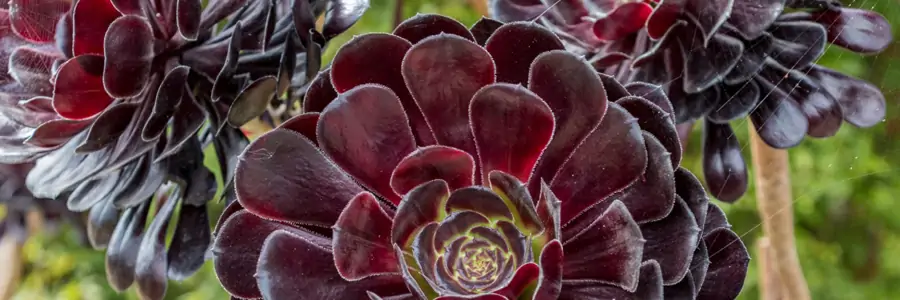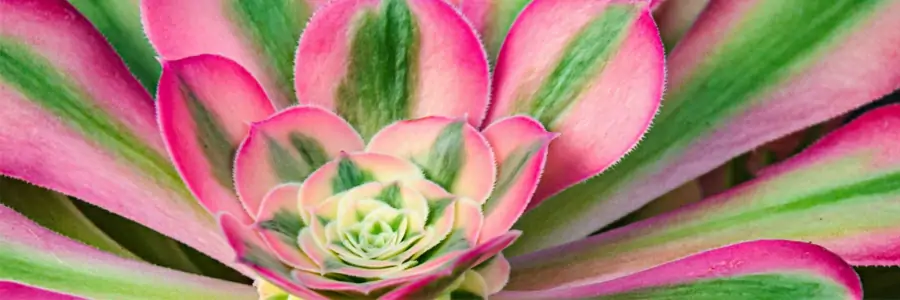Aeonium
Taxonomic Classification
The Aeonium genus belongs to the family Crassulaceae. The name “Aeonium” is derived from the Greek word “aionion”, which means “everlasting”, perhaps referring to the long – lasting nature of these succulent plants. This genus encompasses around 35 species of succulents, native to the Canary Islands, Madeira, Morocco, and parts of East Africa.
Morphological Characteristics
1.Rosette Structure
Aeoniums are well – known for their rosette – shaped growth habit. The rosettes can vary in size from small, compact ones only a few centimeters in diameter to large, showy rosettes that can reach up to 60 centimeters or more. The leaves are arranged in a circular pattern around a central stem, creating an aesthetically pleasing and symmetrical appearance.
2.Leaf Features
The leaves of Aeoniums are generally fleshy and thick, which is a characteristic adaptation for water storage. They come in various shapes, such as oval, lance – shaped, or spoon – shaped. The leaf margins can be smooth, serrated, or even wavy in some species. The colors of Aeonium leaves are diverse, ranging from bright green in many common species to deep burgundy, purple, or variegated combinations. Some varieties have a powdery or waxy coating on their leaves, similar to other succulents, which helps protect them from excessive sunlight and water loss.
3.Stem and Growth Pattern
Aeoniums often have elongated stems, especially in mature plants. Some species grow in an upright manner, while others have a more sprawling or trailing growth habit. As the plants grow, they may produce multiple rosettes along the stem, creating a bushy or tree – like appearance. In some cases, the stems can become woody over time.
4.Flowering Characteristics
Aeoniums produce large, showy flower clusters on tall stalks that emerge from the center of the rosette. The flowers are typically small and star – shaped, and they are grouped together in dense inflorescences. The colors of the flowers can be yellow, white, or pink, depending on the species. Flowering usually occurs in spring or early summer, and in some cases, the mother rosette may die after flowering, but offsets (small plantlets) are often produced before this happens to ensure the plant’s survival.

Common Varieties
1.Aeonium arboreum
This is one of the most common Aeonium species. It has large, green rosettes that can reach up to 30 centimeters in diameter. The leaves are oval – shaped with a pointed tip and a smooth margin. As the plant matures, it develops a woody stem and can grow up to 1 – 2 meters tall, giving it a tree – like appearance. It produces yellow flower clusters in spring.
2.Aeonium ‘Zwartkop’
Also known as Black Rose Aeonium, ‘Zwartkop’ is highly prized for its dark, almost black – purple rosettes. The leaves are lance – shaped and form tight, compact rosettes. It is a relatively small – sized Aeonium, with rosettes usually around 10 – 15 centimeters in diameter. The contrast between its dark foliage and the bright yellow flowers it produces in spring makes it a very attractive addition to any succulent collection.
3.Aeonium haworthii
This species has small, tightly packed rosettes that are typically green with red – tipped leaves. The leaves are narrow and lance – shaped, and the rosettes can form dense clusters. Aeonium haworthii is a slow – growing variety and is well – suited for small pots or rock gardens. It produces white to pale pink flower clusters in spring.
4.Aeonium undulatum
Aeonium undulatum is characterized by its large, wavy – edged leaves. The rosettes are green, and the wavy margins of the leaves give the plant a unique and eye – catching appearance. It can grow up to 30 centimeters in diameter and produces yellow flower clusters on tall stalks in spring. This species is often used in landscaping projects in areas with suitable climates.
5.Aeonium leucoblepharum
This variety has rosettes with pale green leaves that have white, hairy margins. The contrast between the green leaves and the white margins is quite striking. The rosettes are relatively small, usually around 5 – 10 centimeters in diameter. It produces white flower clusters, and its compact size makes it a great choice for indoor succulent arrangements or small outdoor gardens.

